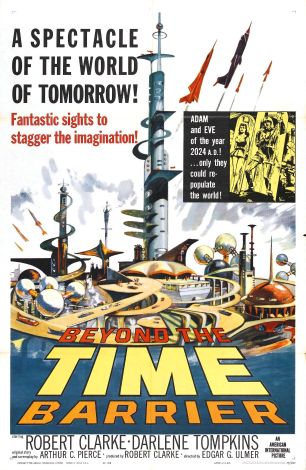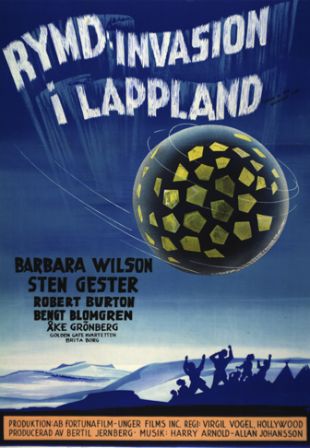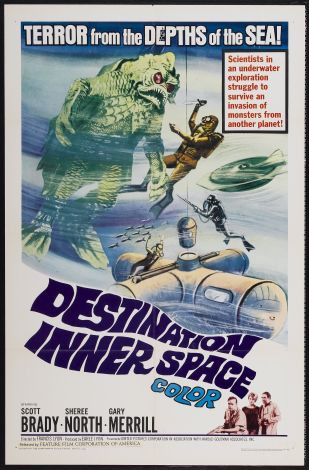Arthur C. Pierce was a screenwriter and sometime producer and/or director of science fiction films. He was born in 1923, and became a movie enthusiast while growing up. The Second World War provided his formal introduction to film production -- he served in the United States Navy as a combat cinematographer, earning a Purple Heart in the process, and some of the film he shot was later used in such feature films as The Sands Of Iwo Jima. He also worked under Edward Steichen in preparing the photographic book Power of the Pacific. After the war, he moved to Hollywood, where he wrote a screenplay about US submarine combat in the Pacific during World War II, which was never produced. He took acting lessons with Ben Bard's company, worked in regional and community theater productions, and got what work there was as a cameraman, prop man and the like in smaller film productions. From 1948 through 1951, he worked for Raphael Wolff Productions as a cameraman and director on industrial films, which took him across the country and to Canada and Mexico, photographing rivers, steel and paper mills, smelting plants, dams, and almost anything else involving manufacturing on the North American continent, all on behalf of some of the largest companies in the United States. His work in this area also gave him an up-close look at what were then called "electronic brains" -- aka computers -- in operation, which may have stimulated his interest in science fiction. He returned to Hollywood in 1952 and went to work for the Howard Anderson Company, one of the top special effects companies in the postwar film world. He learned the creation of effects from the ground up and their various uses, in media ranging from 2D black-and-white to 3-D color. He took a leave from his job in 1954 to produce his first film, a 20-minute-long stop-motion-animation short, in 3-D called "The Adventures of Sam Space," a science fiction tale that involved more than a dozen puppets. The movie was reportedly impressive on a technical level, but by the time it was done, the brief Hollywood boom for 3-D movies had crested and disappeared. He left the Anderson company a couple of years later and started seeking work on a more creative level in Hollywood, assisted by his friend Mark Hanna, an actor-turned-screenwriter, who showed Pierce what he needed to know to pursue a career in the latter field. In 1958, he sold his first screen story, for the anti-war science fiction drama The Cosmic Man (1959), a low-budget production (reminiscent in some ways of The Day The Earth Stood Still) starring Bruce Bennett and John Carradine. A little after this, he sold his first screenplay, for the US release of a Swedish science fiction film called Rymdinvasion i Lappland (later issued as Invasion of the Animal People). In 1959, he wrote the story and screenplay for Edgar G. Ulmer's Beyond The Time Barrier, one of a pair of science fiction thrillers made by the renowned director for a Texas-based company. At the start of the 1960's, Pierce went to work for 20th Century-Fox Studios in the special effects department under L.B. Abbott -- in that capacity, according to an article by Pierce's longtime friend Kevin Danzey, he served as a lizard-wrangler on Journey To The Center of the Earth (1960) and participated in the making of Voyage To The Bottom of the Sea (1961) and Cleopatra (1963), editing the optical effects on the latter movie. By 1964, with help from Lawrence Woolner and Bernard Woolner, Pierce was able to move into the role of producer on a pair of low-budget films that have proved endlessly entertaining across the decades since: Mutiny In Outer Space and The Human Duplicators, the latter run extensively "straight" in the 1960's and 1970's on television, as well as finding a second life as the butt of various jokes on Mystery Science Theater 3000. The story of the two films' production, at least according to one unconfirmed source, would have made a good chapter in an entertainment business textbook. Apparently, the money for Mutiny In Outer Space, which was to be shot in black-and-white, was put up by an East Coast supermarket tycoon who wanted to dabble in film distribution -- the movie was to be shot at Cinecitta Studios in Rome, and Pierce traveled there along with the cast of American players and the director-of-record, Hugo Grimaldi. But the Woolners apparently had a brainstorm ahead of production -- the supermarket magnate had capitalized the movie in such a way, that there was some modest degree of slack in the budget, and they realized that it would be just possible, if everyone was careful with the money and their deal at Cinecitta, to shoot a whole additional movie, which they would own outright. Thus was spawned the espionage/sci-fi thriller The Human Duplicators, starring George Nader, Richard Kiel, Delores Faith, and George Macready (actually, a much better cast than the one in Mutiny In Outer Space, and it was shot in color, as well). The crew, who realized what was happening, with two groups of sets reportedly built, back-to-back, on the same sound stage facilities, would work on Mutiny In Outer Space for half the day, and then that cast would leave, and the cast for The Human Duplicators would come in and do their work. Pierce also ended up taking over the directing from Grimaldi when the latter proved out-of-his-depth, although he was never credited for his work here, or on The Navy Vs. The Night Monsters (1966), parts of which he directed in place of credited director Michael Hoey. He was, however, credited for his work directing Women Of The Prehistoric Planet (1966), a movie whose plot and characters offered surprising parallels to elements that would become familiar on the series Star Trek (and, much later, Star Trek Voyager). Pierce was also the screenwriter for the science fiction thriller Cyborg 2087 (which has elements that would later turn up, more fully formed, in James Cameron's Terminator) and Dimension 5 (both 1966). He remained active as a writer, and must have taken pride in the popularity that some of his movies achieved on television in the 1970's. In later years, Pierce wrote episodes of Fantasy Island and the anthology series The Next Step Beyond. He passed away in 1987.
Arthur C. Pierce
Active - 1959 - 1984 |
Born - Sep 8, 1923 |
Died - Nov 17, 1987 |
Genres - Science Fiction, Spy Film, Mystery
Share on


